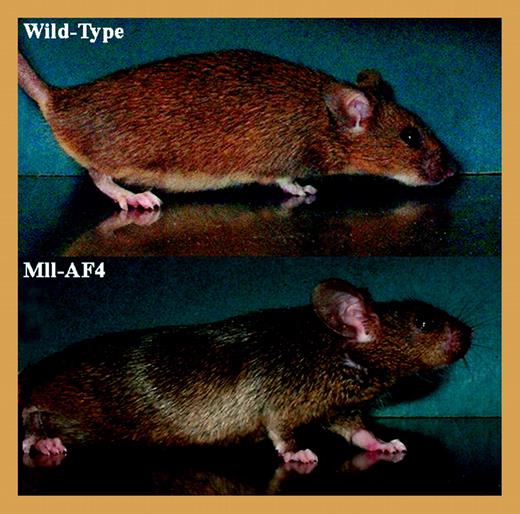Comment on Chen et al, page 669
A report from the Kersey laboratory documents the long-awaited successful establishment of a murine model for leukemogenesis by the Mll-AF4 fusion gene.
The MLL gene is notorious for its promiscuous fusion with multiple alternative partner genes in leukemia, and much ingenuity has been expended in attempting to identify shared or common functional attributes of the resultant proteins.1 Several other intriguing biologic questions arise from a consideration of these different MLL chimeras, including the basis of selective myeloid or lymphoid lineage phenotypes. In principle, this might be ascribed to cell context–dependent transformation or, alternatively, the imposition of a particular lineage phenotype on progeny of multilineage progenitor or stem cells.
Several models for transformation and leukemogenesis by MLL fusion genes have been reported,2 including transformation assays (by replicate cloning) in vitro and leukemogenesis by transformation of stem/progenitor cells in vitro followed by transplantation in vivo, MLL fusion knock-ins (via embryonic stem [ES] cells), or by engineering translocations.3 What has been missing from this story to date (though many labs have tried and failed) is any model at all, in vitro or in vivo, for Mll-AF4, the predominant fusion gene of infant acute lymphoblastic leukemia (ALL) where it is associated with a pro-B or pro-B/monocyte phenotype, remarkably short latency, high white-cell counts, and high-grade malignancy.4 FIG1
Wild-type (top) and Mll-AF4 (bottom) mice at the age of 5 weeks. Mll-AF4 mice have a shortened face and large ears. Mll-AF9 mice have a more pointed face and large ears. See the complete figure in the article beginning on page 669.
Wild-type (top) and Mll-AF4 (bottom) mice at the age of 5 weeks. Mll-AF4 mice have a shortened face and large ears. Mll-AF9 mice have a more pointed face and large ears. See the complete figure in the article beginning on page 669.
Chen and colleagues report in this issue of Blood a model based on Mll-AF4 knock-in to ES cells that has an intriguing phenotype supporting, so the authors contend, an “instructional” model of lineage affiliation (Metzler et al5 are reporting a very similar phenotype with Mll-AF4). In addition to a general skeletal/facial phenotype (big ears, stubby nose; see the figure), young Mll-AF4 mice have a striking increase in both pro–B cells and mixed lympho(B)/myeloid cell colonies with replicate cloning ability (ie, they are transformed). This phenotype is also observed, though to a lesser extent, in Mll-AF9 mice. Malignancies occur but only after a very protracted latency (200-700 days; median, 17 months) and then with a predominant follicular B-lymphoma phenotype. This phenotype was not seen with Mll-AF9 mice; they develop myeloid leukemias, again with long latencies. The early, transformed, or preleukemic stages of disease in these mice more or less mimics what could be expected from the corresponding human disease if, as assumed, the equivalent target cell has been hit. But what is clearly different in this new model is the absence of pro–B-ALL with a brief latency as seen in patients. The authors' speculation that the critical secondary mutations involved in infant ALL are missing seems very plausible, but this still begs an interesting question: why do human fetal stem cells/progenitor cells transformed by Mll-AF4 so rapidly acquire necessary secondary genetic events in the pro–B-cell compartment? One possibility is that transformed pro–B cells in the human fetus are exposed to the transplacental mutagenic chemicals that induced the Mll-AF4 fusion itself,6 and indeed may be ultrasensitive to such insults.7 In the current mouse models, and in the absence of such a genotoxic insult, the main selective pressure for secondary genetic events might be expected to be delivered via the proliferative stress of germinal center activity—in mature B-cell progeny of the transformed progenitors. ▪



